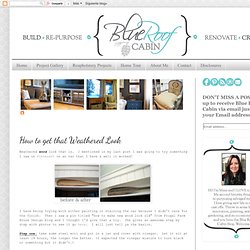

How-to Paint/Distress/Antique Furniture: Project 1 painted green, refinished, and distressed. How-to faux paint antique distressed furniture [video] 3 Simple Ways to Share What You Make With Instructables you can share what you make with the world and tap into an ever-growing community of creative experts.
![How-to faux paint antique distressed furniture [video]](http://cdn.pearltrees.com/s/pic/th/antique-distressed-furniture-22419260)
Create on the go: Groups » Forums » Answers » Featured Groups Login share what you make > How-to faux paint antique distressed furniture [video] by briangrabski + Collection Favorite video How-to faux paint antique distressed furniture [video] This is a 3.5 minute YouTube video I filmed and edited on the technique I use for painting furniture to look old. Flag this comment as: Not Nice Inappropriate Spam "I Made It" comments require images. 4wardthinkers8 months agoReply Great video! Tinker2342 years agoReply thank you so much i really need to weather some wood like objects i was wondering about this thanks About This Instructable 4,550 views 36 favorites License:Public Domain briangrabskiDesigned & MADE Follow74 More by briangrabski Tags:Antique paintingdistressingfaux finishing Related See More About Us Find Us Resources Mobile AndroidiOSWindows Go Pro Today »
Aging is so Distressing – Techniques for Antiquing Furniture. Well, despite the fact that I am starting to feel my age, this post is actually about achieving that well worn, loved, aged and antique look on furniture and decor items.

Aren’t these layers of paint, scratches and wear marks art to your eyes? Nothing shows character like chipping paint and multiple revealed layers on metal. Weathered paint worn thin and rubbed off. or paint splotches on an old ladder. And you can’t forget rust, love that beautiful brown patina! I have been experimenting with several techniques to add age to “newer” pieces of furniture. Throwing the chain in: These are a few of my favorite distressing tools: Throwing a chain at wood gives you those elliptical dents. Sanding through the years: The easiest way to add some age and expose layers of paint is to pull out a power sander. A table that was previously painted white received a beachy blue layer of paint on top of the white.
Darker wood showing through adds instant age. It is important to use a old shaggy brush. How to Artificially Weather Wood Shingles and Siding. Blue roof cabin: How to get that Weathered Look. Weathered wood look that is.

I mentioned in my last post I was going to try something I saw on Pinterest on an oar that I have & well it worked! I have being toying with either painting or staining the oar because I didn't care for the finish. Then I saw a pin titled "how to make new wood look old" from Frugal Farm House Design blog and I thought I'd give that a try. She gives an awesome step by step with photos to see it go here. I will just tell ya the basics. After 24 hours Step two: make a strong cup of tea. Step three: brush on the vinegar mixture. The before pic above is after the tea was brushed on & it was still wet. I'm really excited about this. **edited to add- I sanded the oar down to bare wood removing all of the clear finish. Chemical Ebonizing - Woodworking Techniques. Remember the old slogan, “better living through chemistry”?

When it comes to turning wood black—a process called ebonizing—I prefer the chemical approach, which uses solutions made from vinegar, steel wool and tannic acid. Watching them transform an ordinary wood, such as the yellow poplar I’m using here, is magical. Other methods of ebonizing (dye, ink and paint) use pigments, which can obscure the wood’s grain. The chemical technique leaves an absolutely transparent layer of black. You can still see the wood’s figure and character, particularly after you apply a topcoat. Woodworkers have long known that rusty, acidic water turns some wood black. Mixing the chemicals The two solutions can be stored and used over and over. Eventually, the pad will dissolve and the formerly clear liquid will turn a dark reddish brown, with a black scum on top. The second solution, tannic acid, is made with dry powdered tannin (see Sources, below).
Back2root's deviantART gallery.